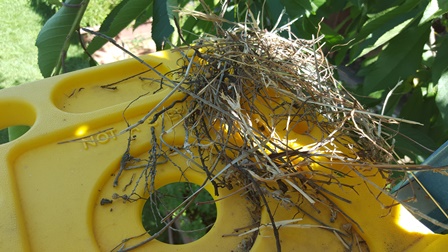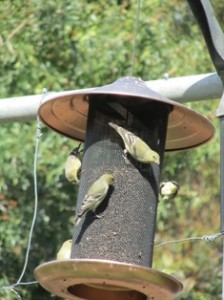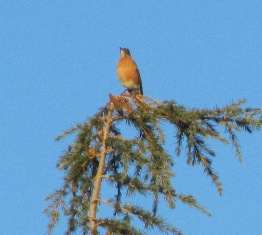Sleuthing Egg Loss and a Nest’s Destruction
What a difference twelve hours makes. When we retired last night, the mourning doves were on their nest atop our tall ladder next to the cherry trees. It was day twelve since the birds built the nest in our garden, so we expected to see babies hatching any day now. Alas, this morning the dove family had fled and there was no sign of eggs or babies.
I believe something raided the nest. It should come as no surprise. Building it on that site seemed like a foolhardy proposition from the start. And to position it on the shelf of the ladder, exposed and near a hole big enough for a chicken egg to fall through seemed a little ridiculous.
And yet, the dove pair dutifully took turns incubating the eggs, even when the mercury hovered at the hundred degree mark on the outdoor thermometer.
In the spirit of helping the family, I kept the fountains filled with fresh water and threw handfuls of birdseed along the stone retaining wall so the pair would have a ready supply of food. Each morning, I’d hurry out to check on the doves before tackling more chores.
When I noticed the nest today and realized it was empty, the eggs were gone, and there was no sight of the doves, I began sleuthing. On the ground near the ladder lay a single long black feather and lots of leaves, knocked from the cherry trees. Not many clues but enough to make a supposition.
I recall that a flock of crows flew in to roost in nearby trees just before dusk last night. They’re both smart and predatory. They’ll raid other nests and eat eggs. I surmised that either they or a local cat or racoon drove away the dove pair and laid waste to the eggs. And yet as I write this, I can see beyond my garden window that a pair of doves are eating the seeds I cast upon the stone wall. Mourning doves can build a nest and lay a set of eggs six times during spring, so there’s still hope.
* * *
If you enjoy reading about wildlife and other topics (including delicious recipes and gardening tips) related to farmette living, check out my cozy mysteries from Kensington Publishing. The first two in the Henny Penny Farmette series are available online at Amazon, Barnes and Noble, Walmart, KOBO Books, and other sites as well as in traditional bookstores everywhere.
BEELINE TO MURDER, see http://tinyurl.com/jo4cxy
MURDER OF A QUEEN BEE, see http://tinyurl.com/zu8s7pf
Attracting Mourning Doves to Your Backyard
Despite its drab brown coloring with pink legs and round eyes, the Mourning Dove (also known as the Turtle Dove, Rain Dove, and the Carolina Turtledove) is one of the most easily recognized backyard birds in America.

The ladder is a tall one for picking cherries, but it works as a platform for a nest constructed by a pair of Mourning Doves
We welcome them to the farmette with the lure of seeds, the type of food that makes up most of their diet. My hubby and I place seeds in low-hanging feeders or on the stone retaining wall. Sometimes, we even cast birdseed near the outer edge of the garden.
These birds also need a source of water. Because we keep chickens and bees, we have fountains running year-round. With an ample supply of food and water and plenty of fruit trees, tall grass, bamboo, and berry bushes for habitat, it’s no wonder the doves and other birds hang around here to mate in spring.
What surprises me is that one Mourning Dove couple has made a nest on top of the ladder I left out while picking some ripe cherries. The nest didn’t look too substantial, but I guess it works for them. I climbed up on a chair nearby to see the two white eggs after the dove left the nest. Within seconds, she dive bombed me and I nearly fell off the chair.
Mourning doves usually lay two eggs that are incubated by both parents, taking turns. In one spring season, they can repeat the process up to six times. This accounts for their population numbers staying strong in the face of being hunted for sport by humans and stalked as prey by other species. The baby doves are called squabs.
I love the lamenting call of these birds, often at sunset. I also appreciate that they are believed to mate for life. The squabs feed on crop milk–regurgitated secretions from the lining of the crop of the parents.
Attracting these doves into your backyard is easy if you put out a feeder and some seeds. For the July-August issue of GRAND online magazine, I’ve created a birdseed hanging saucer with directions so anyone can make it. Ours has attracted several doves who forage for food morning and evening.
* * *
If you enjoy reading about farmette life, check out my mystery novel series from Kensington Publishing, New York. The books feature a farmette milieu, farm sayings, tips, and facts about animals and bees as well as delicious recipes to try. The books are available from online sources such as Amazon, Barnes & Noble, Walmart and others as well as traditional bookstores everywhere.
BEELINE TO MURDER is the first book in Meera Lester’s Henny Penny Farmette series of mysteries.
Novel #2 in the Henny Penny Farmette series, available Oct. 1, 2016
Backyard Bird Watching Soothes the Spirit
Back in my old neighborhood I spent many happy hours watching the birds that flew into the massive pines behind my San Jose home. Then when I moved to the Miami area, I felt thrilled to spot a long-legged, white egret, a small but determined sandpiper, or a bald eagle or two visiting my home on the lake. The visits of those exquisite creatures were always brief and all too soon they would fly back to their nests in the brush or tall pines of the Florida Everglades, only a mile or two away. Now here on the Henny Penny Farmette, I am serenaded every morning by songbirds, often sweet little yellow finches feeding at the feeder five feet above the fence at the back of the property.
If you feed them, they will come. Finches love the black nyger seed. Our local feed store sells the seed in bulk and also in white mesh sacks with tiny holes perfect for finch beaks, which are quite small. Of course, some seeds will drop to the ground and, in my experience, easily sprouts and grows into a tall, skinny plant with a blue bloom. I’ve heard that you can sterilize birdseed so it would not root and grow if you toast the seeds for a short time in the oven on high heat. But be careful not to burn them. Not even birds like burnt food.
While making coffee this morning, I peered out the kitchen widow to see a beautiful bird with a rust colored breast perched atop the fifty foot pine. I believe it was a robin. Grabbing my camera, I got off a couple of shots before the bird took flight. I’m pretty sure I haven’t seen the last of that bird. Rain is coming again in a few days and robins love to hop around searching for worms. So regardless of what neighborhood I’m living in, I create habitat and put out food for the wild birds. It welcomes them and their presence nurtures my spirit.
 Facebook
Facebook Goodreads
Goodreads LinkedIn
LinkedIn Meera Lester
Meera Lester Twitter
Twitter









